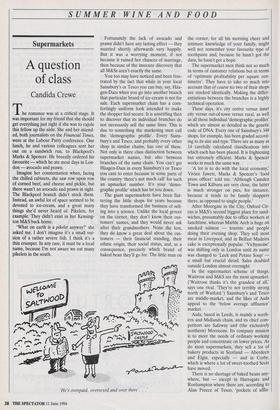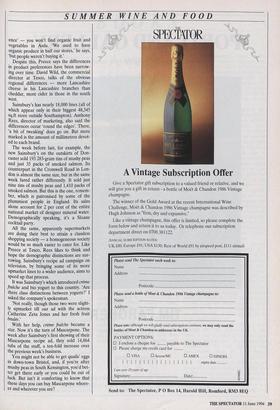SUMMER WINE AND FOOD Supermarkets
A question of class
Candida Crewe
The romance was at a critical stage. It was important for my friend that she should get everything just right if she was to cajole this fellow up the aisle. She and her intend- ed, both journalists on the Financial Times, were at the Labour Party conference. One lunch, he and various colleagues sent her out on a sandwich run, to Blackpool's Marks & Spencer. He breezily ordered his favourite — which he ate most days in Lon- don — avocado and prawn.
Imagine her consternation when, facing the chilled cabinets, she saw row upon row of corned beef, and cheese and pickle, but there wasn't an avocado and prawn in sight. The Blackpool branch didn't stock them. Instead, an awful lot of space seemed to be devoted to ice-cream, and a great many things she'd never heard of. Pikelets, for example. They didn't exist in her Kensing- ton M&S back home.
`What on earth is a pikelet anyway?' she asked me. I don't imagine it's a small ver- sion of a rather severe fish. I think it's a thin crumpet. In any case, it must be a local name, because I'm not aware we eat many pikelets in the south. Fortunately the lack of avocado and prawn didn't have any lasting effect — they married shortly afterwards very happily. But it was a worrying moment, if not because it ruined her chances of marriage, then because of the insecure discovery that all M&Ss aren't exactly the same.
You too may have noticed and been frus- trated by the fact that while in your local Sainsbury's or Tesco you can buy, say, Haa- gen-Dazs when you go into another branch that particular brand of ice-cream is not for sale. Each supermarket chain has a com- fortingly uniform look intended to make the shopper feel secure. It is unsettling then to discover that its individual branches do not necessarily sell the same lines. This is due to something the marketing men call the 'demographic profile'. Every Sains- bury's and Tesco, and probably every other shop in similar chains, has one of these. Not only is there class distinction between supermarket names, but also between branches of the same chain. You can't get Haagen-Dazs in every Sainsbury's or Tesco you care to enter because in some parts of the country 'there's not much call' for such an upmarket number. It's your 'demo- graphic profile' which has let you down.
The giant supermarkets have been flat- tening the little shops for years because they have transformed the business of sell- ing into a science. Unlike the local grocer on the corner, they don't know their cus- tomers' names, and they would never ask after their grandmothers. None the less, they do know a great deal about the cus- tomers — their financial standing, their ethnic origin, their social status, and, as a consequence, precisely which brand of baked bean they'll go for. The little man on the corner, for all his morning cheer and intimate knowledge of your family, might well not remember your favourite type of toothpaste and, because he hasn't got the data, he hasn't got a hope.
The supermarket men think not so much in terms of customer relations but in terms of 'optimum profitability per square cen- timetre'. They have to take so much into account that of course no two of their shops are stocked identically. Making the differ- entiations between the branches is a highly technical operation.
These days, it's city centre versus inner city versus out-of-town versus rural, as well as all those individual 'demographic profiles' which are almost as detailed as the genetic code of DNA. Every one of Sainsbury's 348 shops, for example, has been graded accord- ing to its size and type. There are as many as 14 carefully calculated classifications into which each has been placed. It is frightening but extremely efficient. Marks & Spencer works in much the same way.
`A lot is to do with the local economy,' Vivien Jawett, Marks & Spencer's 'food press officer' told me. 'Although Camden Town and Kilburn are very close, the latter is much stronger on pies, for instance, because it tends to be family shoppers there, as opposed to single people.'
After Moorgate in the City, Oxford Cir- cus is M&S's second biggest place for sand- wiches, presumably due to office workers at lunchtime, whereas Marble Arch is huge on smoked salmon — tourists and people doing their evening shop. They sell most meat in Liverpool, and in Belfast Madeira cake is exceptionally popular. 'Vichyssoise' was shifting only in London until its name was changed to 'Leek and Potato Soup' — a small but crucial detail. Sales doubled outside London almost overnight.
In the supermarket scheme of things, Waitrose and M&S are the most upmarket. (Waitrose thinks it's the grandest of all,' says one rival. 'They're not terribly strong north of Watford.') Sainsbury's and Tesco are middle-market, and the likes of Asda appeal to the 'below average affluence' market.
Asda, based in Leeds, is mainly a north- ern and Midlands chain, and its chief com- petitors are Safeway and (the exclusively northern) Morrisons. Its company mission is to meet the needs of ordinary working people and concentrate on lower prices. As do most supermarkets, they sell a lot of bakery products in Scotland — Aberdeen and Elgin, especially — and in Corby, which is where a lot of sweet-toothed Scots have moved.
There is no shortage of baked beans any- where, but — except in Harrogate and Roehampton where there are, according to Alan Preece of Tesco, 'pockets of afflu-
SUMMER WINE AND FOOD
ence' — you won't find organic fruit and vegetables in Asda. 'We used to have organic produce in half our stores,' he says, `but people weren't buying it.'
Despite this, Preece says the differences in product preferences have been narrow- ing over time. David Wild, the commercial director at Tesco, talks of the obvious regional differences — more Lancashire cheese in his Lancashire branches than cheddar, more cider in those in the south west.
Sainsbury's has nearly 18,000 lines (all of which appear only in their biggest 48,345 sq.ft store outside Southampton). Anthony Rees, director of marketing, also said the differences occur 'round the edges'. There, `a bit of tweaking' does go on. But more marked is the amount of millimetres devot- ed to each brand.
The week before last, for example, the new Sainsbury's on the outskirts of Don- caster sold 193 283-gram tins of mushy peas and just 35 packs of smoked salmon. Its counterpart in the Cromwell Road in Lon- don is almost the same size, but in the same week fared rather differently. It sold just nine tins of mushy peas and 1,410 packs of smoked salmon. But this is the one, remem- ber, which is patronised by some of the plummiest people in England. Its sales alone account for 2 per cent of the entire national market of designer mineral water. Demographically speaking, it's a Sloane cocktail party.
All the same, apparently supermarkets are doing their best to attain a classless shopping society — a homogeneous society would be so much easier to cater for. Like Preece at Tesco, Rees likes to think and hope the demographic distinctions are nar- rowing. Sainsbury's recipe ad campaign on television, by bringing some of its more upmarket lines to a wider audience, aims to speed up that process.
It was Sainsbury's which introduced creme fraiche and bio yogurt to this country. 'Are there class distinctions between yogurts?' I asked the company's spokesman.
`Not really, though those two were slight- ly upmarket till our ad with the actress Catherine Zeta Jones and her fresh fruit brulee.'
With her help, creme fraiche became a star. Now it's the turn of Mascarpone. The week after Sainsbury's first showing of their Mascarpone recipe ad, they sold 14,864 tubs of the stuff, a ten-fold increase over the previous week's business.
You might not be able to get quails' eggs in down-town Bristol, and, if you're after mushy peas in South Kensington, you'd bet- ter get there early or you could be out of luck. But isn't it comforting to know that these days you can buy Mascarpone whoev- er and wherever you are?



































































 Previous page
Previous page